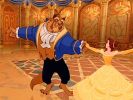Eye For Film >> Movies >> Beauty And The Beast (1991) Film Review
Beauty And The Beast
Reviewed by: Scott Macdonald

The best fables teach us more about the human condition than tell us a story. I like to think that the moral of Madame Leprince de Beaumont's fairy tale is simple - with enough time and suffering, anyone can become a Beast. This makes for an obvious translation to movies, with two standing out above all the others. Jean Cocteau's masterpiece La Belle et la Bete, opts to focus on the inner desires of the Beast and his gentle heart enduring all experiences. Disney's similarly splendid film reflects a selfish heart being warmed by the arrival of the beautiful Belle.
In Disney's film, Belle, a free-spirited woman lives with her crackpot inventor father in southern France. The screenplay quickly draws her as a fiercely independent woman, and invites us to sympathise with her as the town rejects her way of thinking. Even worse, the handsome, repulsively egotistical Gaston wants her as a trophy wife. Belle's father, during a trip to a science fair gets lost, and ends up at an enchanted castle, falling captive to the twisted Beast. Belle comes to the castle, and offers her life to the Beast in exchange for her father's freedom.

Both films share striking visual tone, yet are discrete and sport distinct designs. Cocteau's cinematographer Henri Alekan opts for every trick in his black and white cinematography book to enhance his brand of poetry, while Disney uses different means of vision to lend the film it's own enchanting brand of darkness. These include expressionist background paintings, full of snarling statues, and careful use of light and shadow, evoking the memories of Citizen Kane's Xanadu. Yet as the film progresses, and Belle has had an influence on the castle and temperament of the Beast, the artists lighten things to keep the storytelling elements in balance.
Instead of statues with spooky moving eyes, this version chooses to give life to inanimate objects, giving them purpose and character. Central to these are Lumiere, a troublemaking lover, transfigured into a candlestick, and Cogsworth, an overly sensible, stuck-up lordly fool who has been turned into an enchanted clock. Other characters include the delightful Mrs Potts and her son Chip and they all join forces to help the two obstinate, star-crossed souls find love in each other.
Beauty And The Beast has a clear and effective frugality. Within 15 minutes, we've been introduced to all of the characters, and given the Beast's backstory for later reference. Within 30, we've established absolutely everything needed for the story to progress organically and smoothly to it's climax. It's a remarkably well-paced story, and indeed, it does progress, almost invisibly to a marvellous, crowd-pleasing romantic slice of animated bliss. Both main characters are given considerable weight, and are fully developed into three dimensional beings, leaving us rooting for their union.
Several of the musical numbers stand out, one is the title song, lightly sung by Mrs Potts (Angela Lansbury). It is an exhilarating piece of music and animation, which comes to a climax in the technically challenging ballroom scene. As the characters' feelings soar, so does the camera, while the music lifts the viewer up to complete the experience.
The other musical gem is Gaston, in which the townsfolk gather to praise the villain, a diseased amalgamation of alpha male power fantasies. It's an adorably pompous number in which the antagonists plot to claim Belle as a prize, and provide all the necessary adjuncts to Gaston's dangerous and foolish character.
Beauty And The Beast is a magical film. The sheer craftsmanship, through script, story, song, and unadulterated uplifting emotion is nearly peerless. It ushered in a New Golden Age from Disney, yet the standard has dropped yet again, with the thinly scripted Dinosaur its lowest point. Pixar Animation Studios has taken up the slack with a series of animated triumphs (Finding Nemo, The Incredibles, WALL·E), and Disney has wisely retained it under its wing.
It's the story! All else is secondary.
Reviewed on: 15 Nov 2008
















